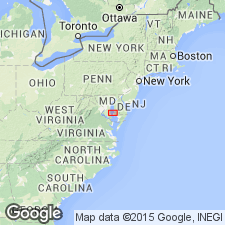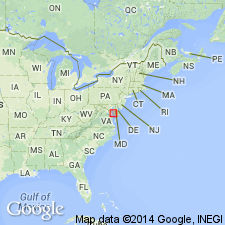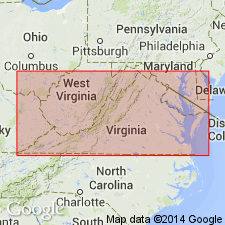
- Usage in publication:
-
- Boston Cliffs Member
- Modifications:
-
- Named
- Dominant lithology:
-
- Sand
- AAPG geologic province:
-
- Atlantic Coast basin
Summary:
Boston Cliffs Member of Choptank Formation here named in Talbot Co., MD. Extends across Chesapeake Bay to VA. Described as 4.6 m of fossiliferous brown sand at Boston Cliffs along Choptank River. Gradationally overlies St. Leonard Member and underlies Conoy Member (both new names) of Choptank Formation. Age is middle Miocene.
Source: GNU records (USGS DDS-6; Reston GNULEX).

- Usage in publication:
-
- Boston Cliffs shell bed
- Modifications:
-
- Revised
- AAPG geologic province:
-
- Atlantic Coast basin
Summary:
Though elevated to formal member status by Gernant (1970), this author retains informal usage "to avoid name proliferation." Unconformably underlies St. Marys Formation; unconformably overlies Drumcliff shell bed. Thickness ranges from 0.6 to 3.6 m. Covers an area of 3,000 square km. Age is late Miocene. [See also Kidwell, 1989, Jour. Geol., v. 97, no. 1, p. 1-24.]
Source: GNU records (USGS DDS-6; Reston GNULEX).

- Usage in publication:
-
- Boston Cliffs Member*
- Modifications:
-
- Overview
- AAPG geologic province:
-
- Atlantic Coast basin
Summary:
Dominant sediment type of the Boston Cliffs Member of the Choptank Formation varies from reddish-brown to moderate brown, muddy to slightly muddy, fine sand. The most distinguishing characteristic is the prolific accumulation of shells. Thickness is approximately 13 ft at type section; elsewhere thicknesses vary between 3 and more than 15 ft. Lower contact with St. Leonard Member is gradational; upper contact with Conoy Member is sharp and distinct with an oxidized indurated sequence below and the nonresistant dusky-blue, fine sand of the Conoy above.
Source: GNU records (USGS DDS-6; Reston GNULEX).
For more information, please contact Nancy Stamm, Geologic Names Committee Secretary.
Asterisk (*) indicates published by U.S. Geological Survey authors.
"No current usage" (†) implies that a name has been abandoned or has fallen into disuse. Former usage and, if known, replacement name given in parentheses ( ).
Slash (/) indicates name conflicts with nomenclatural guidelines (CSN, 1933; ACSN, 1961, 1970; NACSN, 1983, 2005, 2021). May be explained within brackets ([ ]).

